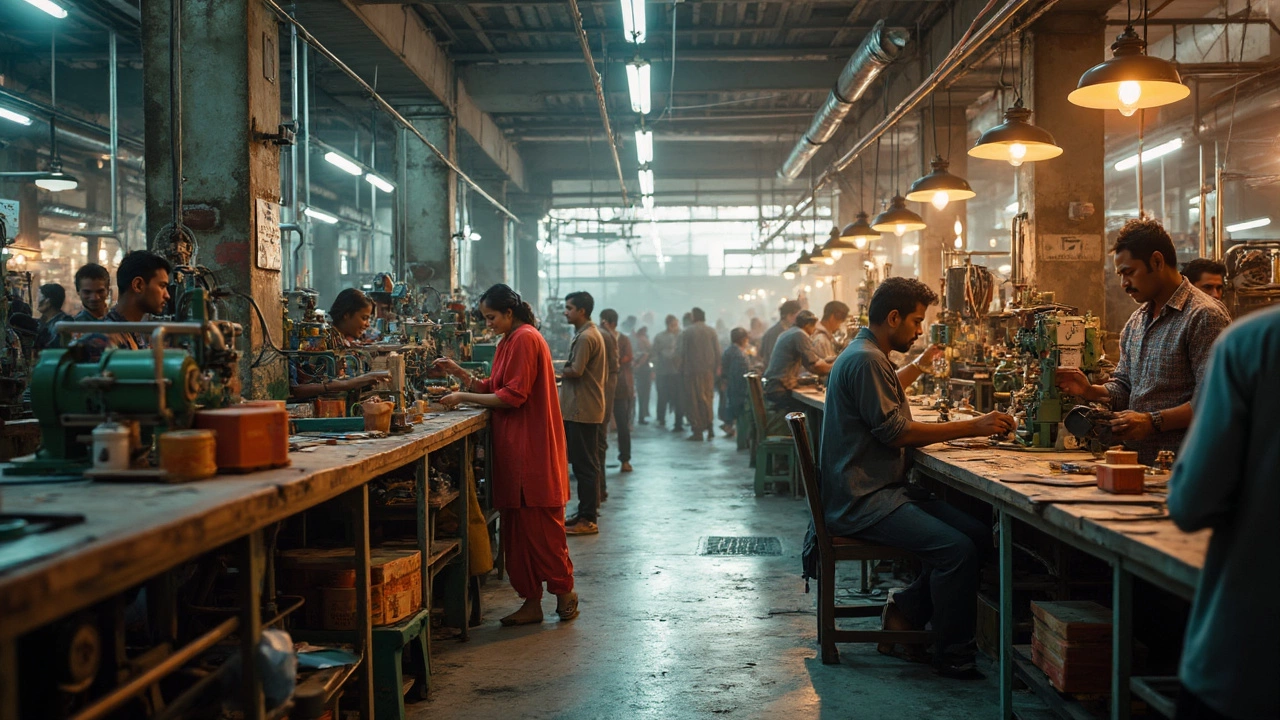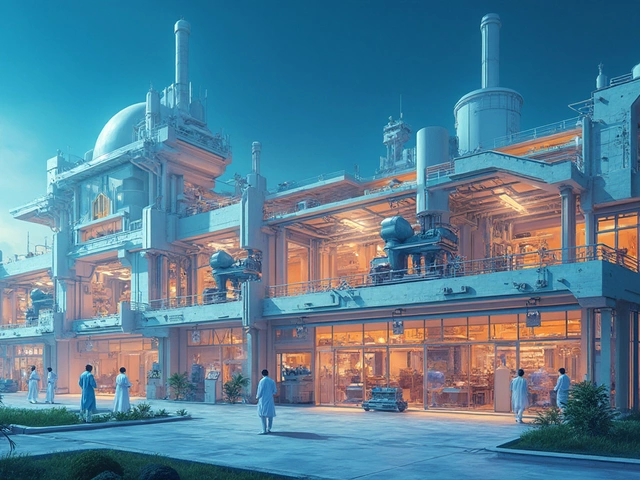If you think manufacturing is just about factories and machines, you’re missing half the story. Picture a small town where a new plant opens up—suddenly, people have work, local shops get more customers, and even small cafés see new faces at lunch hour. There’s a whole chain reaction, all set off by those assembly lines.
But here’s where it gets really interesting: manufacturing doesn’t just mean jobs on the factory floor. It also creates work for electricians, drivers, cleaning staff, and people in nearby businesses. That extra cash in everyone’s hands? It usually gets spent right there in town, turning a single company into the engine for a whole local economy.
And let’s not forget the families. When parents have steady work, it means better access to healthcare, schooling, and a shot at a brighter future. These changes don’t just show up on paper—they show up at dinner tables, crowded markets, and packed school buses. If you want to see real examples, just look at towns where a government-backed scheme helped start a cluster of factories. Quite often, these places see a drop in unemployment and a boost in everyday life.
- Boosting Jobs and Income
- New Businesses and Local Services
- What Government Schemes Really Do
- Manufacturing’s Ripple Effect on Community Life
Boosting Jobs and Income
When a factory sets up shop in a town, hiring doesn’t stop with assembly line workers. You’ll see openings for transport, security, maintenance, HR, and even contract jobs like food vendors and local suppliers. This ripple effect is the main reason the manufacturing sector has always been a huge driver for boosting employment everywhere—from big cities to rural areas.
Here’s something you can’t ignore: in India, around 12% of the workforce is directly tied to manufacturing. Every 100 direct factory jobs often create anywhere from 200 to 300 more indirect jobs, according to the Ministry of Micro, Small and Medium Enterprises. This isn’t just numbers—it’s people getting a shot at steady pay, benefits, and better living standards. Instead of migrating to faraway cities, locals can find jobs nearby, keeping families together and helping whole neighborhoods thrive.
Wages in manufacturing can also lift up the average income in a region. Let’s say the monthly wage for an entry-level worker in an industrial cluster is ₹12,000 compared to about ₹8,000 in the local service sector. That extra cash often gets spent on housing, transport, groceries, and kids’ education—funneling money right back into the community.
| Job Type | Average Monthly Wage (INR) | Usual Benefits |
|---|---|---|
| Assembly Worker | 12,000 | PF, Health Insurance |
| Driver | 10,000 | ESI, Fuel Allowance |
| Machine Operator | 15,000 | PF, Bonus |
| Warehouse Staff | 11,000 | Gratuity, Uniform |
There’s also a link between manufacturing and upskilling. Local colleges and skill centers often tweak their programs to match what new factories need. That means more people get trained in welding, electronics, or logistics—and become more employable, now and in the future.
If you look up towns with clusters built through government schemes like the Production-Linked Incentive (PLI), you’ll notice job rates going up, while people’s average incomes climb steadily. It’s not magic—it’s a sign that a serious focus on manufacturing can change the economic reality for entire communities.
New Businesses and Local Services
Here’s something most people don’t think about: when a manufacturing unit starts up, business doesn’t just grow inside the factory. It pops up all around it. You’ll see stuff like new delivery services, tool repair shops, and food stalls popping up close to large plants. According to an actual NITI Aayog policy review from 2022, every new manufacturing job can lead to the creation of up to 1.5 more jobs in supporting sectors. That’s not just a random stat—just ask anyone who’s seen a factory town grow from scratch.
Manufacturing plants need supplies, quick repairs, and ways to get products out the door. Local businesses step up to fill those needs—think packaging suppliers, transport services, and mechanics. Over time, these support companies become strong businesses themselves. In Gujarat, for example, the Spinning Mills cluster turned small machine shops and logistics firms into backbone industries for the region.
It doesn’t stop there. Employees need places to eat, shop, and get a haircut. So restaurants, grocery stores, medical clinics, and even gyms move in. This cycle keeps money moving within the local economy instead of it leaving for bigger cities. That sense of opportunity keeps folks local, so you see fewer people migrating for work.
If you’re wondering what to watch for when a new factory comes to your area, check:
- Rising number of local shops and service providers
- New startups catering to bigger company needs (transport, safety, catering, etc.)
- More foot traffic in markets and on main streets
- Greater demand for housing and rentals
When the big factory next door does well, it doesn’t just fill its own parking lot. It fills the town’s main street, gives local kids better job options, and can even lift up dozens of family-run businesses at the same time.

What Government Schemes Really Do
So, let’s break down how government schemes actually work when it comes to manufacturing. These schemes aren’t just a bunch of forms or promises—they’re real support systems for factories, workers, and even entire towns.
One super popular example is India’s Production Linked Incentive (PLI) scheme. It basically pays companies extra cash for every extra unit they make, as long as they hit certain targets. Suddenly, those businesses have a reason to hire more people, invest in better machines, and think bigger. There are similar programs in other places—the US has the CHIPS Act for chip manufacturing, and Vietnam’s government gives tax breaks and cheap land to new plants. The idea is always the same: make it easier and more appealing for companies to build and expand locally.
But money isn’t the only carrot. Some schemes help with:
- Skill-building: Free or cheap training for workers so the local talent pool actually matches industry needs.
- Infrastructure upgrades: Building better roads, electricity lines, or water supply so transportation and operations go smoother.
- Easy loans and credit: Small manufacturers or startups get loans at lower interest, which means less risk and more chance for success.
- Export help: The government steps in to help local companies find buyers outside the country, so they’re not stuck fighting for scraps at home.
The real magic happens when these schemes target entire regions or specific sectors where jobs are needed most. For example, plastic parks in Gujarat or textile hubs in Tamil Nadu are a direct result of government incentives. Jobs grow, and local entrepreneurs pop up with services and shops, taking the whole area along for the ride.
If you run a small business, look out for state-level grant programs or industry clusters near you. They can be a shortcut to cheaper power, land, equipment, or even help with getting skilled workers. You don’t need to be a big factory to join in—these benefits often spill over to smaller suppliers, food stalls, and even transport operators.
Manufacturing’s Ripple Effect on Community Life
Once a manufacturing unit starts up in a local area, the changes are everywhere—not just in paychecks but in the way people live. A new factory can mean cleaner parks, more school buses, and even improved hospitals. Why? Because more jobs usually mean higher local tax collections, which the government can use to make the neighborhood better for everyone.
There’s a reason why towns with active manufacturing zones often have fewer people moving out in search of work. According to the Reserve Bank of India, districts with at least one large manufacturer saw their annual migration rates drop by 15% in just three years. That’s not a small number when you consider how hard it can be for families to move for work.
But it doesn’t just stop at jobs. You get new learning opportunities, like technical schools or skill training centers, popping up to support the industry. These centers help locals upgrade their skills and grab better jobs down the line. Plus, with more funding flowing through, you find more sports clubs, libraries, and women’s self-help groups getting active.
- Local businesses like grocery stores, auto repair shops, and clinics see increased demand.
- Government schemes focused on manufacturing, such as the Production Linked Incentive (PLI) scheme, often make it easier for young people to join the workforce or start small ventures.
- Community events become more frequent, and local markets get livelier, because more people have disposable income.
Here’s a practical look at how manufacturing can lift up a whole area:
| Impact Area | Before New Factory | After New Factory |
|---|---|---|
| Primary School Enrollment (%) | 61 | 74 |
| Average Daily Market Footfall | 1,500 | 2,300 |
| Local Clinic Visits (Monthly) | 400 | 750 |
These aren’t just numbers; they represent evenings when the market is buzzing and mornings when kids walk to school with packed lunchboxes. Manufacturing, when managed well, can really lift the whole community—not just a lucky few.





